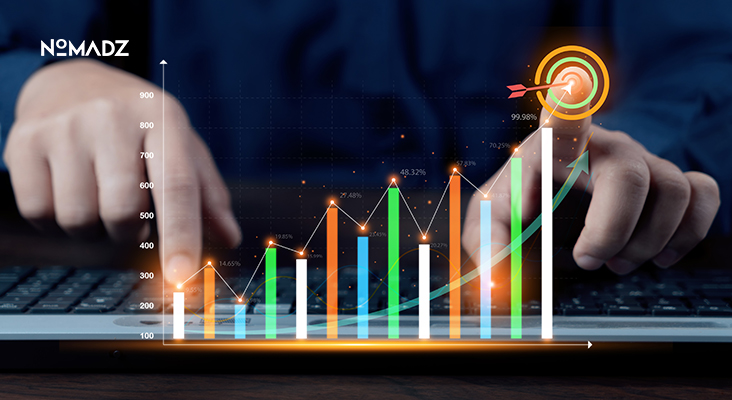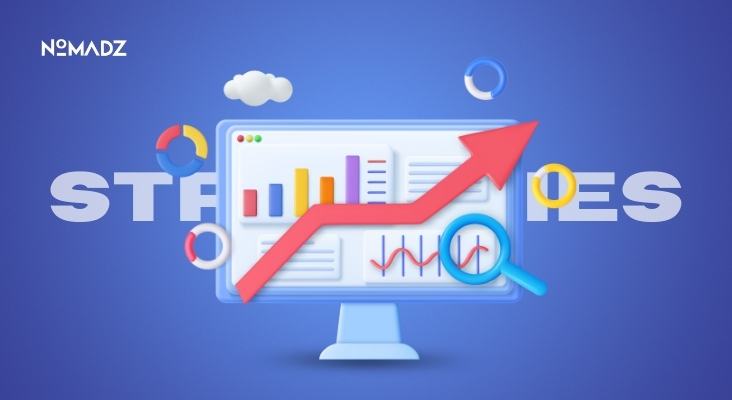Top 6 Performance Marketing Trends to Watch in 2025
Several factors are driving the changes in performance marketing, including precision, data, and technology. Performance marketing trends aim to gather data only for things that are easy to measure, like clicks, conversions, sales, and certain behaviors. Therefore, businesses that care about measuring ROI continue to invest most of their budgets in it.
Best 6 Emerging Performance Marketing Trends to Look Out For
In 2025, new performance marketing trends like AI-powered targeting, data privacy shifts, and social commerce are changing how marketers plan, execute, and optimize their campaigns. Many of these shifts are already visible in recent marketing campaigns, and 2025 has started to showcase, especially in retail and e-commerce.
Much of what’s performance trending now is closely tied to automation and personalization. Let’s break down the top 6 performance marketing trends that will shape strategy in 2025.
AI Developments Are Having a Big Impact on Digital Advertising
Advancements in Artificial Intelligence for marketing took place in 2023 and are expected to be even greater in 2025. Due to Google’s Performance Max and Meta’s Advantage + Shopping Campaigns, marketers can automatically perform bidding, targeting, and even creative testing.
AI improves the efficiency of ads and helps brands anticipate what people are likely to do by looking at their browsing, buying, and engagement habits. AI will power many areas in 2025, some like:
- Ads that are created based on what is important to each person.
- People are thinking about adapting how they group their audiences.
- Allocating the budget with the help of technology.
- Real-time improvement of performance.
For example, a fashion company can automatically display unique ads for a large audience depending on the season, a person’s location, or their earlier buying habits. The takeaway? Every business needs to work with AI. Any marketer not using machine learning and automated tools is likely to fail.
Also Read: Performance Marketing Top Strategies and Tips for Beginners
First-party Data is Being Viewed as a Key Asset by Many Companies
Since privacy is a priority, businesses are now focusing more on first-party data instead of third-party cookies. Marketers are trying to build direct relationships with buyers and collect information through their sources.
Successful brands in 2025 will be characterized by the following:
- Use loyalty programs, quizzes, and gated content to gather your users’ information.
- Consolidate this data through customer data platforms (CDPs)
- Set up a lookalike audience using the most important customer groups.
This isn’t only about following the rules and securing your business’s control. Following such performance marketing trends, if you have customer data, you can use it to craft strong targeting approaches and lessen your reliance on Facebook and Google advertising.
Using first-party data, a skincare brand may customize emails for users depending on their skin type or previous purchases. This approach results in better campaign open rates and more sales.
There is a Rapid Growth in Retail Media Networks
Retail Media Networks (RMNs) like Amazon Ads, Walmart Connect, and Target Roundel are becoming powerful platforms for performance marketers. Advertisers can reach customers before making their purchases; many other ads do not provide this option. In 2025, we might witness Registered Mental Nurses practice in more areas.
- Connected TV (CTV) and streaming platforms.
- Stores are using electronic displays for their signs and menus.
- Ads that show inside retail-owned mobile applications.
What is the significance of this? The reason is that their first-party data is full of important details. A performance marketing network like Amazon targets people who have chosen similar products in the past. It isn’t easy to surpass that amount of concentration.
Retail media is predicted to grow to $140 billion in just a few years, making it a fast-growing sector in digital advertising.
Also Read: Top Data Analysis Tools to Use in 2025
Predictive Analytics Helps Focus on Individuals
Although AI is important, we want to highlight predictive analytics today. Thanks to historical user data, marketers can anticipate what someone will do and adjust the content accordingly. With new performance marketing trends, organizations will utilize predictive analytics for the following reasons.
- Recognize what might cause people to churn ahead of time.
- So you can buy and recommend products based on your history.
- Send offers that are most likely to be successful for your customers.
With data, an online store might remember your re-order period and reach out two days before, helping you keep ordering longer. Therefore, marketers should use ML tools, engage with their data groups, and switch to making proactive campaign plans.
More and More People Are Using Social Commerce Every Day
The link between social media and e-commerce is getting stronger and faster every day. Instagram and Pinterest are rolling out shoppable posts, in-app buying, and live shopping features that make online purchases quick and easy for users.
Looking ahead, the best performance marketing campaigns will:
- Use influencers to get your products noticed.
- Make it simple for users to buy directly in the app.
- Organize product tags and catalogs more effectively to get the most out of social platforms.
One example is a fitness brand paying micro-influencers to wear their clothes in Instagram Reels and include a link-in-bio for easy shopping. This kind of social commerce speeds up the path to purchase and reflects key performance trends shaping how brands connect with buyers.
Also Read: Big Data Analytics Platforms for 2025: A Comprehensive Guide
The Way We Optimize Websites is Now Being Affected by Voice Search and Conversational AI
Now, Alexa, the Google Assistant, and SIRI are all very common, affecting how people find information. It is expected that more than half of all searches in the future will be made by voice, which greatly affects the performance of SEO and SEM.
Marketers need to do the following:
- Optimize content for natural language queries (e.g., “best headphones under $100” vs. “cheap headphones”).
- Schema markup can help you show up often in results when speaking to voice assistants.
- Prepare answers to the same questions that might be spoken aloud.
Besides, using chatbots and virtual assistants as ongoing performance marketing trends has become important for helping users and generating leads. Try putting AI chat tools on your landing pages to support users, respond to their questions, and increase their chances of converting, especially if they visit your site on a mobile device.
Conclusion
Performance marketing means paying attention to precision, personalization, and prediction, not only ad clicks and conversions. For marketers to do well in 2025 and beyond, they must rely on AI, plan high-quality first-party data, and keep up with the ever-changing platforms they use.
These six performance marketing trends aren’t just fads. They outline how effective campaigns are made and explain how companies can keep up in today’s data-driven performance marketing industry. Implement changes now, and you will be ready to lead when the most important changes begin.
FAQs
Q. Which direction are the performance marketing trends taking?
Performance marketing is changing to depend more on automation, personalized solutions, and data control. Thanks to AI, predictive analytics, and retail media, marketers can reach and persuade their audiences.
Q. What will change in the world of marketing by the year 2025?
People can expect more customization, improved use of information collected directly, and more tasks carried out by AI. Marketers will have to focus their campaigns more accurately and understand predictive tools.
Q. Which companies make use of performance marketing?
E-commerce companies, software businesses, service providers, and businesses that deal with other companies all use performance marketing to track ROI. The usual routes are Google Ads, Meta Ads, working with influencers, and affiliate marketing.
Q. Why is performance marketing useful?
To get actual results in areas like website visitors, leads, sales, or number of app downloads. It makes it easy for marketers to measure their returns based on how much money they have invested.
Q. How would you explain the main concept of performance marketing?
It’s a way of marketing online where ads are only charged when a certain goal is reached, such as someone clicking on them, providing their contact details, or making a purchase. All the performance marketing trends are set to report results that can be measured.









Leave feedback about this